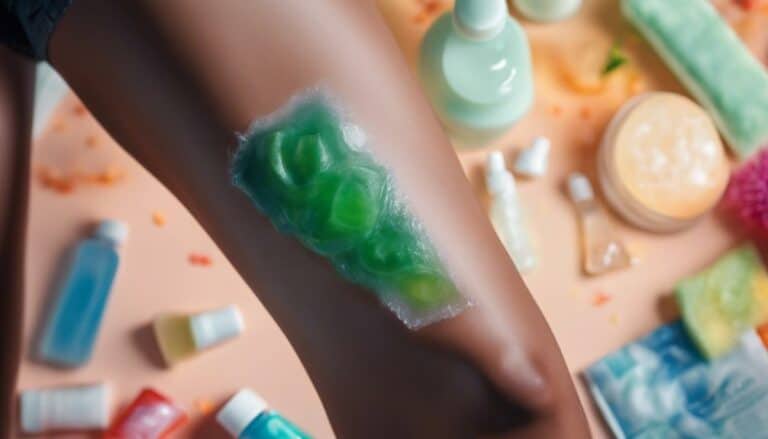Did you know that thigh hickeys are more common than you might think, with a recent survey revealing that over 60% of individuals have experienced or given one at some point?
Understanding the intricacies of how these marks form, why they appear, and the best ways to handle them is crucial, especially when it comes to intimate moments. But what exactly causes thigh hickeys to form, and how can you effectively manage them?
Stay tuned to uncover all you need to know about this intriguing phenomenon on thighs.
Key Takeaways
- Thigh hickeys are caused by intense kissing, targeting erogenous zones like the thighs.
- Thigh hickeys can be easily concealed and last from a few days to over a week.
- Healing process involves color changes from red to brownish or yellowish hues.
- Communication, consent, and understanding healing factors are crucial for thigh hickey activities.
What Is a Hickey?
A hickey is a bruise that develops as a result of intense kissing or sucking on the skin, caused by the rupturing of blood vessels beneath the surface. When these blood vessels break due to the suction or pressure applied during moments of intimacy, a hickey forms. Hickeys on thighs, a discreet location for intimate marks, are a common result of passionate encounters in that area. The skin on the thighs is sensitive, making it prone to bruising when subjected to such actions.
As with any bruise, the color of a thigh hickey changes as it heals. Initially, it may appear red or purple, but over time, it transitions to brownish or yellowish hues. The healing process of thigh hickeys varies depending on factors like the severity of the bruising and the individual's skin type. These marks typically last anywhere from a few days to over a week before fading completely.
Formation of Thigh Hickeys
When engaging in intimate moments, the delicacy of the skin on the thighs makes them a prime location for the formation of thigh hickeys due to the ease with which capillaries can rupture under pressure. During intense kissing or sucking on the thighs, capillaries can burst, causing blood to be released into the surrounding tissue, giving thigh hickeys their characteristic color.
The thighs, being sensitive areas, are prone to capillary breakage during such moments, facilitating hickey formation. Compared to more exposed areas like the neck, thigh hickeys are less noticeable, making them a preferred location for some individuals. The intensity of kissing on thighs plays a significant role in causing the capillaries to break and subsequently forming these marks.
Reasons for Thigh Hickeys
Thigh hickeys often result from the intense pressure applied during intimate moments, leading to the breaking of capillaries and the subsequent formation of visible marks on the skin. Thighs, being erogenous zones, are commonly targeted during passionate encounters, where intense kissing or sucking can cause capillaries to rupture, resulting in the discreet bruising that forms hickeys.
The sensitivity of thigh skin makes it susceptible to bruising, making thigh hickeys a common outcome of intimate interactions. These marks are easily concealed by clothing, providing a hidden area for expressing intimacy without drawing public attention.
The choice to create thigh hickeys may stem from the desire for a private display of affection, utilizing this sensitive and easily hidden location to leave a mark that signifies intimacy shared in secret.
Duration of Thigh Hickeys
The duration of thigh hickeys typically ranges from a few days to over a week, similar to the healing process of hickeys on other body parts. When it comes to thigh hickeys, several factors can influence how long they last. Here are some key points to keep in mind:
- Bruising Severity: The extent of bruising can impact how quickly a thigh hickey fades.
- Healing Abilities: Individual healing capabilities play a role in determining the duration of thigh hickeys.
- Skin Type and Blood Circulation: Factors like skin type and blood circulation affect the speed at which thigh hickeys heal.
- Color Change and Kissing Intensity: Thigh hickeys may evolve in color as they heal, with the intensity of the initial kissing or sucking affecting the healing time.
Understanding these aspects can give you a better idea of how long you can expect a thigh hickey to linger.
Potential Risks and Considerations
Excessive suction during the creation of thigh hickeys may result in potential blood vessel damage and discomfort. The capillaries in the thighs are fragile, making them susceptible to breaking during intense kissing or sucking.
It's crucial to communicate with your partner and obtain consent before engaging in hickey-related activities on the thighs. Understanding the risks associated with thigh hickeys can help ensure a safe and enjoyable experience. If any issues or discomfort arise from thigh hickeys, seeking professional advice is advisable.
Being mindful of the intensity of suction and the duration of the activity can help prevent blood vessel damage and any potential discomfort. Prioritizing safety, communication, and mutual consent is essential when exploring intimate activities like thigh hickeys.
Remember to listen to your body and your partner's cues to ensure a pleasurable and risk-free experience.
Conclusion
As you navigate the realm of intimacy, understanding the intricacies of thigh hickeys is key. From their formation to their healing process, these marks offer a visual representation of passion and connection. Remember, communication and consent are paramount in any intimate encounter.
Embrace the beauty of these temporary marks, knowing that they're a symbol of shared moments and affectionate gestures. Stay informed, stay safe, and enjoy the journey of exploration.

